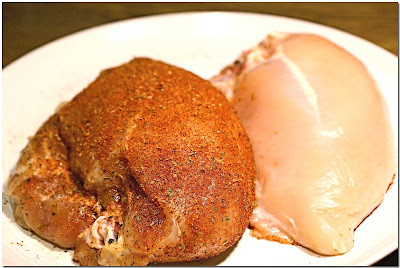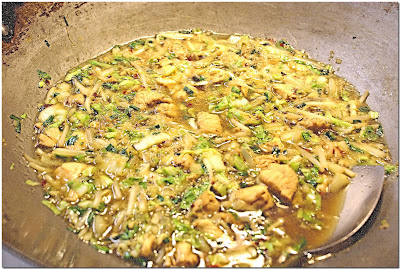Citrus-Spiked Beef Brisket
>> Friday, March 29, 2013
 |
What's a "Christian Seder"? We generally followed the Jewish Seder ritual by tasting the ceremonial foods that remind them of their captivity in Egypt: salt water for tears, bitter herbs, matzo for unleavened bread, a fruit-and-nut compote for the bricks they had to make, and so forth. The youngest person asks the ritual questions like, "Why is this night so different from all others?" and the people around the table tell the story of Moses and the Exodus from Egypt.
The Christian part comes into several places. As our Messiah has already come, we focus on his death and resurrection during the ceremony, as well as the longing of the Jews for their savior. Near the end of the ceremony, there is one part where a piece of matzo is broken and eaten, then a last toast is given, and these are the places where Jesus would likely have offered the first communion words. It is a beautiful ritual that involves the whole family, and as Christians, it reminds us of Jesus's Jewishness and the reverence of the Jewish people.
Ingredients
One 4-6 pound beef brisket
Salt and freshly ground pepper to taste
1 tablespoon vegetable oil or olive oil
2 medium onions, thickly sliced
6 carrots, peeled and cut crosswise
8 cloves garlic, 6 peeled and smashed & 2 pressed through a garlic press
1 tablespoon cider vinegar
1 cup dry white wine
3 cups beef, vegetable, or chicken stock
3 small tomatoes, halved
2 sprigs fresh thyme, or ½ teaspoon dried thyme
1 sprig of fresh rosemary
1 bay leaf
5 sprigs fresh parsley, plus ¼ cup chopped fresh parsley
One ½- inch slice of fresh ginger
1 lemon
1 orange
Preheat the oven to 500°F. Pour the oil into a Dutch oven over medium heat. Brown the meat on all sides, then set aside. Add the onions, carrots, and remaining garlic cloves to the Dutch oven, and saute until soft. Raise the heat, pour in the cider vinegar, and stir with a wooden spoon to scrape up any bits that have stuck to the pan. Add the white wine and continue stirring, allowing the liquid to reduce for a few minutes.
Put the meat back in the pot, then add the broth, tomatoes, thyme, bay leaf, parsley sprigs, and ginger. Slice the lemon and orange and arrange on the top of the meat (be sure to remove the seeds!). Cover, and place in the oven for 10 minutes. Then lower the oven temperature to 250°F, and continue cooking for 4 to 4½ more hours, or until very tender.
Remove the meat and vegetables from the pot. Discard the citrus peels, thyme, rosemary and parsley sprigs, ginger, and bay leaf. Slice the meat across the grain. Puree the vegetables with the sauce and re-heat if it has grown lukewarm. To serve, spoon a pool of the hot vegetable puree onto each plate, then place several slices of the meat over the puree.
Serves 10-12.
Read more...
Salt and freshly ground pepper to taste
1 tablespoon vegetable oil or olive oil
2 medium onions, thickly sliced
6 carrots, peeled and cut crosswise
8 cloves garlic, 6 peeled and smashed & 2 pressed through a garlic press
1 tablespoon cider vinegar
1 cup dry white wine
3 cups beef, vegetable, or chicken stock
3 small tomatoes, halved
2 sprigs fresh thyme, or ½ teaspoon dried thyme
1 sprig of fresh rosemary
1 bay leaf
5 sprigs fresh parsley, plus ¼ cup chopped fresh parsley
One ½- inch slice of fresh ginger
1 lemon
1 orange
Directions
Sprinkle the meat with salt and pepper. Rub in the 2 garlic cloves pressed, 1 tsp each of minced thyme, rosemary, and parsley. Dry marinate the brisket a minimum of 1 hour, or preferably overnight.Preheat the oven to 500°F. Pour the oil into a Dutch oven over medium heat. Brown the meat on all sides, then set aside. Add the onions, carrots, and remaining garlic cloves to the Dutch oven, and saute until soft. Raise the heat, pour in the cider vinegar, and stir with a wooden spoon to scrape up any bits that have stuck to the pan. Add the white wine and continue stirring, allowing the liquid to reduce for a few minutes.
Put the meat back in the pot, then add the broth, tomatoes, thyme, bay leaf, parsley sprigs, and ginger. Slice the lemon and orange and arrange on the top of the meat (be sure to remove the seeds!). Cover, and place in the oven for 10 minutes. Then lower the oven temperature to 250°F, and continue cooking for 4 to 4½ more hours, or until very tender.
Remove the meat and vegetables from the pot. Discard the citrus peels, thyme, rosemary and parsley sprigs, ginger, and bay leaf. Slice the meat across the grain. Puree the vegetables with the sauce and re-heat if it has grown lukewarm. To serve, spoon a pool of the hot vegetable puree onto each plate, then place several slices of the meat over the puree.
Serves 10-12.




































